
Let’s talk begonias. Begonias are useful plants. They not only make excellent houseplants, but they can be used as bedding plants outdoors. They fit well into planters, hanging baskets, and window boxes. They are a very versatile plant. The different varieties look so different that the inexperienced gardener might be hesitant to call some of them begonias. Th There are 8 different categories of begonias as delineated by Brad Thompson in an article published by the American Begonia Society. Other sources may give them different names or leave out some of the types that are less frequently grown but a society that dedicates itself to begonias seems a reliable source. Some of them we are likely to find in our local plant sources, some are less common and some we are never going to see in our area.
Let us start with the most commonly grown begonia. This type of begonia is technically known as Semperflorens. It is what grandma called a wax begonia because of the shiny leaves that look as though they are coated in wax. Wax begonias are perennials but are only hardy to zone 10 or 11. In colder climates, they are grown as house plants but also as bedding plants. In the latter case, they are treated as annuals. This is a begonia that likes full sun except in the hottest of areas where they will need some afternoon shade. Wax begonias do not like cold weather and should not be planted out until temperatures reach 60°F on a regular basis. If the plants are not blooming either they aren’t getting enough sun or the temperatures are too low. They bloom best when the temperature is in the mid 70 range. Wax begonias like high humidity, well-drained soil, and sufficient water to keep the soil damp but not continuously wet. One of the few problems with this plant is root rot.
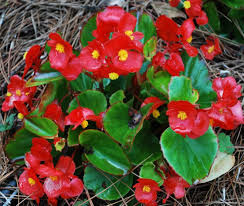
Wax Begonia
Wax begonia plants are uniform and form nicely rounded mounds making them ideal for mass plantings. They range from 6-8 inches in height for the dwarf varieties and 10-12 inches for the taller types. The flower shades are somewhat limited as they are available only in pink, white, red, and rose. They make up for this limitation by contrasting those flower shades with a variety of leaf colors ranging from green through maroon to deep bronze. There are also variegated leaf types. Typically the flowers are small and flat but double flowers are available. The flowers make up for their small size by totally covering the plant and remaining in continuous bloom These begonias are easily propagated by putting cuttings in water and keeping them warm.
Most gardeners are familiar with tuberous begonias. They grow up from a tuber although there is one type that is frequently used for bonsai that has a caudex. The caudex is a swelling at the base of the stem. The caudiciform begonias have small pink or white flowers. In contrast, the rest of the tuberous begonias have every possible color of flower except blue. The flowers can range from ½ up to 8 inches in diameter. These plants are grown primarily for their flowers. The flowers can be single or double and have toothed or ruffled edges. Some have contrasting edges or markings. They bloom throughout the summer with proper deadheading. This type of begonia is frequently used as a bedding plant but it is also useful in pots and hanging baskets. Tuberous begonias are available in both upright and pendulous forms. These begonias are shade-loving and prefer indirect to dappled sunlight. A sheltered area where they are protected from the wind is best for these rather delicate plants. The soil should be kept evenly moist requiring adequate drainage. Tuberous begonias are not tolerant of dry soil.

Tuberous Begonia
Tuberous begonias are native to tropical South America and southern Africa. They are not winter hardy north of zone 10. They must be taken indoors and either grown as a house plant and overwintered indoors but because of its need for high humidity and inclination to root rot, it is best if given a dormancy period over winter. The tubers should be stored at 40°-50° in a paper bag or box. The tubers should be replanted indoors a month prior to the last frost date. As the shoots develop the trick to larger (but fewer) flowers is to pinch off some of the flower stems leaving 3-6 per large tuber. Plants are set out when all danger of frost is past.
If tuberous begonias are grown for their spectacular flowers the Rex begonias are known for their multicolored leaves. They are available in a multitude of shapes, colors, and sizes. Colors range from pink, through red to deep wines and magentas. They may be lined, swirled, or splotched with silver or contrasting colors. The leaves can grow, depending on the type, up to 9 inches long by 5 inches wide but most are much smaller. The plants are usually from 12 to 18 inches in height. The plants do flower but the flowers are insignificant. While Rex begonias can be grown in well-drained soil outdoors they are generally grown in pots.
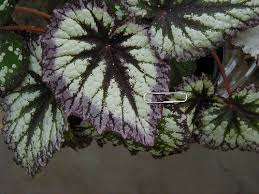
Rex Begonia
Rexes are true shade lovers. While they may be grown in a shade garden they are primarily house plants. There are hundreds of different varieties that breeders have developed from the original plants native to India. Rex begonias are generally classified by leaf size: small (under 3 inches), medium (3-6 inches), and large (over 6 inches). The Rex begonias are fairly fussy. They like well-drained soil and deep watering rather than watering more often. The soil must dry before the plants are watered again. Excess water causes the rotting of the roots. Salts in the water will accumulate in the edges of the leaves and cause them to brown. Distilled water eliminates this problem. If a Rex begonia loses its leaves in the fall or winter do not despair. Many of them take a rest period and will soon put out new leaves.
Cane begonias are better known as angel wing begonias. While there are other varieties of cane begonias this is the most commonly grown type. These begonias have a long segmented, sturdy stem that gives them their common name. Their leaves are deeply divided and are frequently splashed with silver. They are most frequently used as house plants and can be heavy bloomers. They like a warm, humid environment and filtered sunlight. Another variety known as Superba is a larger type that is frequently grown outdoors in the south. They can have leaves that grow up to 14 inches in length and the plants can grow to 12 feet.

Angel Wing Begonia
Shrub begonias come in many sizes from miniatures up to plants that grow to 12 feet. They get their name from the fact that they produce multiple stems from ground level. These begonias are hardy from zones 9-11 and while some are grown as basket plants they are most commonly grown outdoors in warmer climates. They like warm humid growing conditions and well-drained soil. There are many different types but they all have the irregular, elongated leaves typical of begonias as well as the attractive markings. None of them tolerate much sun but those with shiny leaves will cope better with sun than those with hair leaves. They bloom in spring and summer with pink, white, or red flowers either singly or in clusters.

Shrub Begonia
Rhizomatous begonias are grown mostly for their interesting leaves although some produce massive displays of flowers in the spring. The leaves can be small or up to 3 feet. They come in many shapes and colors with different and interesting markings. Some varieties have deep purple leaves that are almost black. These begonias are grown outdoors only under tropical or semi-tropical conditions although some are grown as house plants in the north. One of these is the beefsteak begonia. While there are many varieties of Begonia erythrophylla that have been dubbed beefsteak begonias the historic one has rounded olive, shiny leaves with red undersides. This is one of the oldest hybrid begonias having been hybridized in 1845. It is very easy to grow preferring shade or partial shade. Like all begonias, it likes to go dry between waterings.
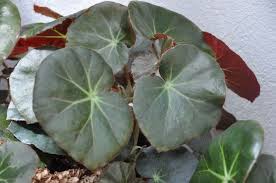
Rhizomatous Begonia
Scandent begonias are trailing plants that are mostly grown for their growth habit. In their native habitat, they will grow up trees. They are tropical plants so they can only be grown outdoors in warmer climates. They can be grown in greenhouses or a sunny window in the north. Since the stems are fragile they must be grown where they will not be disturbed. Overwatering is a definite no-no. Like most begonias, they come with multiple leaf shapes and colors. The flowers are usually pink or white and they put on a show in the spring. Some newer types will bloom longer and some are considered ever blooming.
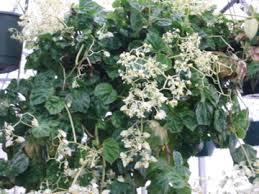
Scandent Begonia
Lastly, we have thick-stemmed begonias. They are not a very popular begonia and it is unlikely that any of us living in zone 5 are likely to see one unless we travel. They grow from a single stem and are very tall. According to the American Begonia Society, some grow as high as a house. They like lots of light and rarely branch or flower. Their leaves are generally confined to the tips of the plant. They are grown as an oddity.
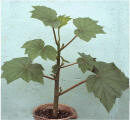
Thick Stemmed Begonia
There are so many types of begonias. that it is impossible to even begin to describe even a small portion of them. All that can be said is that most of them have interesting leave and like to be dry between waterings. They take a varying amount of light but generally will not grow in full sun. All are tropical or semi-tropical. It is possible to grow many of them as houseplants and generally, they are grown as annuals in the north when used outdoors. There are so many and they are so different that there is one for every taste.